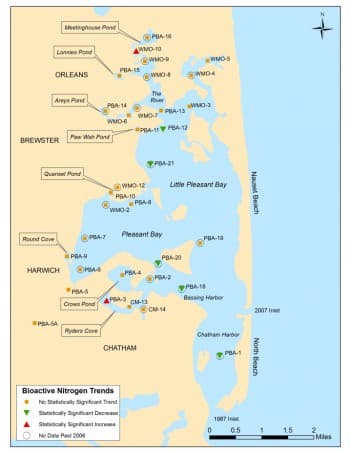Assessment of Water Quality in Pleasant Bay, Massachusetts
How Cadmus provided a community with the necessary information to make an important decision about its natural environment.
Pleasant Bay is an estuarine system located on Cape Cod in the towns of Orleans, Chatham, Harwich and Brewster, Massachusetts. The Pleasant Bay Alliance was formed in 1998 to oversee the implementation of a resource management program developed by the four towns, which includes a bay-wide water quality monitoring program.
Challenge
The Patriots’ Day storm of 2007 caused a “break” in Nauset Beach, resulting in an increased tidal range and volume of water exchanged with the Atlantic Ocean. This increase in the rate and volume of water exchanged between the bay and the ocean is expected to influence water quality in the bay, potentially impacting the local communities’ ability to achieve the water quality goals of an existing total maximum daily load (TMDL). The Pleasant Bay Alliance contracted with Cadmus to conduct an analysis of trends in various water quality parameters before and after the break in order to better inform their decision regarding potential wastewater treatment upgrades.
Solution
In order to inform the Pleasant Bay community on the bay’s water quality status, Cadmus:
- Conducted statistical analyses of water quality data previously collected at 33 sites throughout Pleasant Bay.
- Used the results of those analyses to evaluate both site-specific and bay-wide trends.
- Created a report based on our findings. The report was intended for a broad audience and included general descriptions of the basic methods upon which our analysis was founded.
- Presented the results of our analysis at a public meeting, where we fielded questions from local media outlets and concerned community members alike.
The site-specific analysis demonstrated that water quality was improving at some sites, but declining at others. While the increased exchange of water between the Atlantic Ocean and Pleasant Bay (as a result of the 2007 inlet formation) may be responsible for limited improvements in water quality in some open areas of the bay, bioactive nitrogen concentrations continued to exceed restoration targets established by the Massachusetts Estuary Program. Furthermore, inlet formation in the Pleasant Bay system is thought to be “quasi-cyclical,” with new inlets typically migrating south along Nauset Beach over a period of several years. As the new inlet migrates southward, tidal flushing of the bay may decrease to previous levels and nutrient concentrations may return to pre-inlet concentrations.
Results
While the results of our analysis alone do not provide the Pleasant Bay community with definitive answers on whether or not it should invest the millions of dollars that would be required for the wastewater system upgrades, the analysis does provide objective and quantitative information to help guide them through this debate.
The final report is available for download from The Pleasant Bay Alliance’s website.
Learn more about our Watershed Science and Management services.
